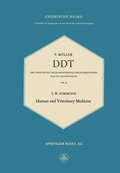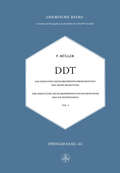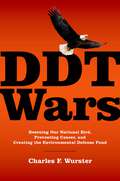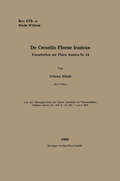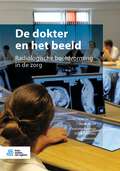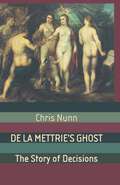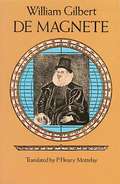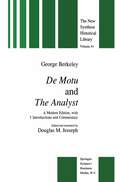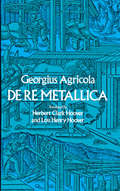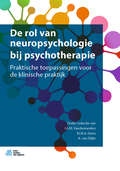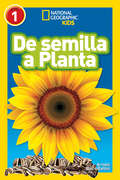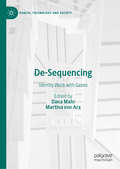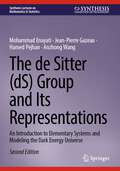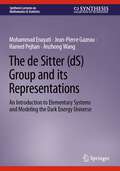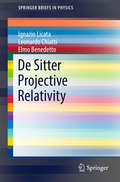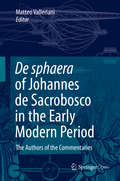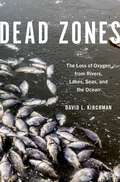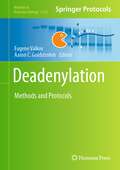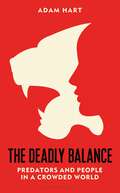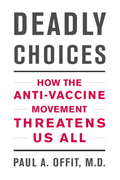- Table View
- List View
DDT: Human and Veterinary Medicine (Lehrbücher und Monographien aus dem Gebiete der exakten Wissenschaften #10 )
by Paul Müller Samuel William SimmonsDDT Das Insektizid Dichlordiphenyltrichloräthan und Seine Bedeutung: The Insecticide Dichlorodiphenyltrichloroethane and its Significance (Lehrbücher und Monographien aus dem Gebiete der exakten Wissenschaften #9)
by P. MüllerDDT in food chain (large print)
by RnibThis is a labelled pyramid diagram showing how a pesticide becomes more concentrated in the bodies of animals further along the food chain. There is a locator dot shown, which will be at the top left of the page when the image is the correct way up. The population of each animal is represented by a rectangle. Earthworms, with the largest population are at the bottom of the page. The earthworm's predator, the blackbird, is up the page from this and the blackbird's predator, the peregrine falcon which has the smallest population, is at the top of the pyramid in the centre of the page. Each dose of DDT is represented by a solid dot (red in the Large Print version).
DDT in food chain (UEB contracted)
by RnibThis is a labelled pyramid diagram showing how a pesticide becomes more concentrated in the bodies of animals further along the food chain. There is a locator dot shown, which will be at the top left of the page when the image is the correct way up. The population of each animal is represented by a rectangle. Earthworms, with the largest population are at the bottom of the page. The earthworm's predator, the blackbird, is up the page from this and the blackbird's predator, the peregrine falcon which has the smallest population, is at the top of the pyramid in the centre of the page. Each dose of DDT is represented by a solid dot (red in the Large Print version).
DDT in food chain (UEB uncontracted)
by RnibThis is a labelled pyramid diagram showing how a pesticide becomes more concentrated in the bodies of animals further along the food chain. There is a locator dot shown, which will be at the top left of the page when the image is the correct way up. The population of each animal is represented by a rectangle. Earthworms, with the largest population are at the bottom of the page. The earthworm's predator, the blackbird, is up the page from this and the blackbird's predator, the peregrine falcon which has the smallest population, is at the top of the pyramid in the centre of the page. Each dose of DDT is represented by a solid dot (red in the Large Print version).
DDT Wars: Rescuing Our National Bird, Preventing Cancer, and Creating the Environmental Defense Fund
by Charles F. WursterDDT Wars is the untold inside story of the decade-long scientific, legal and strategic campaign that culminated in the national ban of the insecticide DDT in 1972. The widespread misinformation, disinformation and mythology of the DDT issue are corrected in this book. DDT contamination had become worldwide, concentrating up food chains and causing birds to lay thin-shelled eggs that broke in the nests. Populations of many species of predatory and fish-eating birds collapsed, including the American Bald Eagle, Osprey, Peregrine Falcon and Brown Pelican. Their numbers recovered spectacularly in the decades following the ban. During the campaign DDT and five other insecticides were found to cause cancer in laboratory tests, which led to bans of these six pesticides by international treaty in 2001. This campaign produced lasting changes in American pesticide policies. The legal precedents broke down the court "standing" barrier, forming the basis for the development of environmental law as we know it today. This case history represents one of the greatest environmental victories of recent decades. DDT is still "controversial" because it has been deceptively interjected into the "climate wars." This campaign was led by the Environmental Defense Fund (EDF), founded in 1967 by ten citizens, most of them scientists, volunteers without special political connections or financial resources. Their strategy was to take environmental problems to court. There were many setbacks along the way in this exciting and entertaining story. The group was often kicked out of court, but a few determined citizens made a large difference for environmental protection and public health. Author Charles Wurster was one of the leaders of the campaign. The first six years of EDF history are described as it struggled to survive. Now EDF is one of the world's great environmental advocacy organizations defending our climate, ecosystems, oceans and public health.
DDT Wars: Rescuing Our National Bird, Preventing Cancer, and Creating the Environmental Defense Fund
by Charles F. WursterDDT Wars is the untold inside story of the decade-long scientific, legal and strategic campaign that culminated in the national ban of the insecticide DDT in 1972. The widespread misinformation, disinformation and mythology of the DDT issue are corrected in this book. DDT contamination had become worldwide, concentrating up food chains and causing birds to lay thin-shelled eggs that broke in the nests. Populations of many species of predatory and fish-eating birds collapsed, including the American Bald Eagle, Osprey, Peregrine Falcon and Brown Pelican. Their numbers recovered spectacularly in the decades following the ban. During the campaign DDT and five other insecticides were found to cause cancer in laboratory tests, which led to bans of these six pesticides by international treaty in 2001. This campaign produced lasting changes in American pesticide policies. The legal precedents broke down the court "standing" barrier, forming the basis for the development of environmental law as we know it today. This case history represents one of the greatest environmental victories of recent decades. DDT is still "controversial" because it has been deceptively interjected into the "climate wars." This campaign was led by the Environmental Defense Fund (EDF), founded in 1967 by ten citizens, most of them scientists, volunteers without special political connections or financial resources. Their strategy was to take environmental problems to court. There were many setbacks along the way in this exciting and entertaining story. The group was often kicked out of court, but a few determined citizens made a large difference for environmental protection and public health. Author Charles Wurster was one of the leaders of the campaign. The first six years of EDF history are described as it struggled to survive. Now EDF is one of the world's great environmental advocacy organizations defending our climate, ecosystems, oceans and public health.
De Cerastiis Florae Iranicae: Vorarbeinten zur Flora Iranica Nr. 14 (Sitzungsberichte der Österreichischen Akademie der Wissenschaften #175/7/8)
by Wilhelm MöschlDe dokter en het beeld: Radiologische beeldvorming in de zorg
by Mario Maas Charlotte Nusman Frank Smithuis Roel BenninkRadiologische beelden worden gemaakt bij nagenoeg elke patiënt die in contact komt met de hedendaagse zorg.De beelden zijn overal te bekijken, maar kun je er ook echt iets in zien? Heb je tijdens je studie geleerd te zien wat er (on)zichtbaar afwijkend is? Dat is het domein van de radioloog. De analogie met een rondwandeling door een willekeurig museum ligt voor de hand: je kan veel rondkijken, met een gids of een audiotour in de hand kun je daadwerkelijk meer zien. De dokter en het beeld geeft aan de hand van voorbeelden uit de praktijk inzicht in de rol van radiologische beeldvorming in de zorg. Veelvoorkomende ziektebeelden van de diverse deelgebieden binnen de radiologie worden beschouwd vanuit drie perspectieven: de verwijzer, de radioloog en de patiënt. Deze uniforme doch multidimensionale methodiek geeft de lezer op overzichtelijke wijze inzicht in de rol van beeldvorming in de zorg.
De La Mettrie's Ghost: The Story Of Decisions (Macmillan Science)
by C. NunnThis book is about how we make choices. Drawing together evidence from 21st century chemistry to Victorian politics, enlightenment philosophy, Roman drama and beyond, it is a compelling hunt for the nature of free will.
De Magnete
by William GilbertMuch of modern science is based upon the theories and discoveries of William Gilbert, the brilliant English physician and physicist who was the first great experimental scientist. Gilbert was the first to use the word "electricity," to recognize mass as distinct from weight, to discover the effect of heat upon magnetic bodies, to differentiate clearly between static electricity and magnetism, and to explain phenomena of terrestrial magnetism in terms of the earth as a giant magnet.In 1600 he published De Magnete in Latin. As lively and entertaining as it was scientifically scrupulous, it summarized everything that had previously been known about electricity and magnetism, founded a new science and earned Gilbert the title of "the father of modern electricity." In it Gilbert explores magnetism and electricity, lodestones, phenomena of magnetism, direction of the earth's magnetic lines of force, variation in the compass, dip, the concept of the earth as a giant magnet, and much else.This Dover edition is a complete, unabridged reprinting of the definitive English translation of De Magnete prepared by Dr. P. Fleury Mottelay. Dr. Mottelay has added a number of footnotes that explain points that might be obscure to today's readers, who will find in this historically important text invaluable insights into the origins of modern science and physics. Translation by P. F. Mottelay. Biographical introduction. 90 illustrations.
De Motu and the Analyst: A Modern Edition, with Introductions and Commentary (The New Synthese Historical Library #41)
by G. BerkeleyBerkeley's philosophy has been much studied and discussed over the years, and a growing number of scholars have come to the realization that scientific and mathematical writings are an essential part of his philosophical enterprise. The aim of this volume is to present Berkeley's two most important scientific texts in a form which meets contemporary standards of scholarship while rendering them accessible to the modern reader. Although editions of both are contained in the fourth volume of the Works, these lack adequate introductions and do not provide com plete and corrected texts. The present edition contains a complete and critically established text of both De Motu and The Analyst, in addi tion to a new translation of De Motu. The introductions and notes are designed to provide the background necessary for a full understanding of Berkeley's account of science and mathematics. Although these two texts are very different, they are united by a shared a concern with the work of Newton and Leibniz. Berkeley's De Motu deals extensively with Newton's Principia and Leibniz's Specimen Dynamicum, while The Analyst critiques both Leibnizian and Newto nian mathematics. Berkeley is commonly thought of as a successor to Locke or Malebranche, but as these works show he is also a successor to Newton and Leibniz.
De Re Metallica: De Re Metallica. Libri Xii. . . (Dover Earth Science)
by Georgius AgricolaOriginally published in 1556, Agricola's De ReM etallica was the first book on mining to be based on field research and observation — what today would be called the "scientific approach." It was therefore the first book to offer detailed technical drawings to illustrate the various specialized techniques of the many branches of mining, and the first to provide a realistic history of mining from antiquity to the mid-sixteenth century. For almost 200 years, Agricola remained the only authoritative work in this area and by modern times it had become one of the most highly respected scientific classics of all time. A book more often referred to in literature on mining and metallurgy than any other, its Latin text prevented it from being as widely used as it might have been. <p><p> In 1912, the book was translated by former President Herbert Clark Hoover and his wife. Printed in a limited edition, the work was quickly bought up by book collectors, historians, and medievalists, who had found that there was much to be learned from its pages. The book contains an unprecedented wealth of material on alluvial mining, alchemy, silver refining, smelting, surveying, timbering, nitric acid making, and hundreds of other phases of the medieval art of metallurgy. The text even covers the legal aspects of mining the use of boundary stones, forfeitures of titles, safety requirements of tunnel building in the 1500s, and so on. <p> But the plates, perhaps more than anything else, have insured Agricola's continued importance. Brilliantly executed drawings, richly detailed, reveal a whole medieval world of machinery, industrial technique, tools, even costume and architecture. All 289 of the original woodcuts are reproduced in this reprint of the 1912 edition, offering students of the period, commercial artists, engineers, metallurgists, and even curious general readers an unforgettable picture of the first age of technology.
De rol van neuropsychologie bij psychotherapie: Praktische toepassingen voor de klinische praktijk
by J.A.M. Vandermeulen M.M.A. Derix A. Van DijkeDit boek laat zien hoe neuropsychologische problematiek kan interfereren bij psychotherapeutische behandeling. Door hier meer op te focussen, kun je effectiever behandelen en misdiagnostiek voorkomen. Het beschrijft welke problemen je kan tegenkomen bij de behandeling, en welke kennis van neuropsychologische stoornissen nodig is bij aanvang en tijdens de behandeling. Tevens biedt het boek praktische handvatten voor de behandeling in de klinische praktijk. De rol van neuropsychologie in de psychotherapie is opgebouwd uit drie delen. Het algemene gedeelte gaat over de relatie tussen psychotherapie en neurowetenschappen, over kwetsbaarheid en veerkracht en over ontwikkelingsneuropsychologische perspectieven. In het tweede praktijkgericht deel komen de meest voorkomende psychische en psychiatrische problemen aan de orde, zoals depressie, chronische vermoeidheid, posttraumatisch stressstoornissen, ADHD en somatische symptoomstoornissen. Ook leest u over de mogelijke inzet van E-health bij de behandeling van deze patiënten. Deel drie, het tweede praktijkgerichte deel, richt zich op de gevolgen van niet aangeboren hersenletsel (NAH), zoals de identiteit na een NAH, beperkte cognitieve stoornissen, emotionele problemen en gesprekstherapie na hersenletsel. Daarnaast komt ook de mogelijke inzet van E-health bij behandeling van NAH aan de orde. Het boek richt zich op psychologen, psychotherapeuten en psychiaters werkzaam in de ggz. Het boek is eveneens goed bruikbaar binnen de diverse ggz-opleidingen.
De Semilla a Planta (National Geographic Reader)
by National Geographic Kids Kristin Baird RattiniLos niños observan las plantas, las flores y los arboles a su alrededor todos los días.
De-Sequencing: Identity Work with Genes (Health, Technology and Society)
by Dana Mahr Martina Von ArxAre you your genes? De-Sequencing: Identity Work with Genes explores this perplexing question, showing how different forms of knowledge must be contextualized to become meaningful. It is generally assumed that the genomic sequence adds up to the identity-forming material life is made of. Yet identity cannot itself adopt the form of a sequence. As the authors in this volume show, the genome must be ‘de-sequenced’ by human language to render it interpretable and meaningful in a social context. The book unpacks this type of ‘sequence-speech’ in engaging detail, adopting a personal, social, cultural, and bio-political approach to examine the transformation of human identity and reflexivity in the era of genetic citizenship.
The de Sitter: An Introduction to Elementary Systems and Modeling the Dark Energy Universe (Synthesis Lectures on Mathematics & Statistics)
by Mohammad Enayati Jean-Pierre Gazeau Hamed Pejhan Anzhong WangThis Second Edition is a comprehensive update, integrating the latest research and theoretical advancements in the field of de Sitter (dS) group representations. Building on the success of the first edition, the book offers a more in-depth analysis of mathematical aspects, conceptual foundations, and practical implications related to the dS group, including its Lie manifold, Lie algebra, and co-adjoint orbits, viewing the latter as potential classical elementary systems within the context of dS spacetime. Additionally, the examination of unitary irreducible representations (UIRs) sheds light on the potential existence of quantum elementary systems within the dS spacetime framework. The authors emphasize consistency with Wigner's approach to elementary systems, incorporate Wigner's principles and exploring projective UIRs of the dS group, and provide a deeper insight into the nature of dS elementary systems. Particular attention is paid to: the “smooth” transition from classical to quantum theory, the physical content under vanishing curvature, and the thermal interpretation from a quantum perspective. The book also focuses on the physical interpretation of elementary systems in curved spacetimes, recognizing the limitations of traditional concepts derived from flat Minkowski spacetime and the Poincaré group.
The de Sitter: An Introduction to Elementary Systems and Modeling the Dark Energy Universe (Synthesis Lectures on Mathematics & Statistics)
by Jean-Pierre Gazeau Mohammad Enayati Hamed Pejhan Anzhong WangThis book reviews the construction of elementary systems living in de Sitter (dS) spacetime, in both the classical and quantum senses. Field theories on dS spacetime are among the most studied mathematical models of the Universe, whether for its earlier period (inflationary phase) or for its current phase of expansion acceleration (dark energy or cosmological constant). Classical elementary systems are Hamiltonian phase spaces, which are associated with co-adjoint orbits of the relativity group. On the other hand, quantum elementary systems are associated with (projective) unitary irreducible representations of the (possibly extended) relativity group (or one of its covering). This study emphasizes the conceptual issues arising in the formulation of such systems and discusses known results in a mathematically rigorous way. Particular attention is paid to: “smooth” transition from classical to quantum theory; physical content under vanishing curvature, from the point of view of a local (“tangent”) Minkowskian observer; and thermal interpretation (on the quantum level), in the sense of the Gibbons-Hawking temperature. Such a mathematical construction is of paramount importance to the understanding of the early Universe (due to the critical role that the dS metric plays in the inflationary cosmological scenarii) as well as to the construction of possible models for late-time cosmology (since a small positive cosmological constant or dark energy seems to be required by recent data). In this sense, this book uniquely blends mathematical physics (spacetime symmetry on classical and quantum levels) and theoretical physics (quantization, quantum field theory, and cosmology). Moreover, the level of exposition varies in different parts of the book so that both experts and beginners alike can utilize the book.
De Sitter Projective Relativity: State Of The Art For Particles, Fields And Cosmology (SpringerBriefs in Physics)
by Ignazio Licata Leonardo Chiatti Elmo BenedettoThis book presents the Projective approach to de Sitter Relativity. It traces the development of renewed interest in models of the universe at constant positive curvature such as "vacuum" geometry. The De Sitter Theory of Relativity, formulated in 1917 with Willem De Sitter's solution of the Einstein equations, was used in different fields during the 1950s and 1960s, in the work of H. Bacry, J.M. LevyLeblond and F.Gursey, to name some important contributors. From the 1960s to 1980s, L. Fantappié and G. Arcidiacono provided an elegant group approach to the De Sitter universe putting the basis for special and general projective relativity. Today such suggestions flow into a unitary scenario, and this way the De Sitter Relativity is no more a "missing opportunity" (F. Dyson, 1972), but has a central role in theoretical physics. In this volume a systematic presentation is given of the De Sitter Projective relativity, with the recent developments in projective general relativity and quantum cosmology.
De sphaera of Johannes de Sacrobosco in the Early Modern Period: The Authors of the Commentaries
by Matteo VallerianiThis open access book explores commentaries on an influential text of pre-Copernican astronomy in Europe. It features essays that take a close look at key intellectuals and how they engaged with the main ideas of this qualitative introduction to geocentric cosmology. Johannes de Sacrobosco compiled his Tractatus de sphaera during the thirteenth century in the frame of his teaching activities at the then recently founded University of Paris. It soon became a mandatory text all over Europe. As a result, a tradition of commentaries to the text was soon established and flourished until the second half of the 17th century. Here, readers will find an informative overview of these commentaries complete with a rich context. The essays explore the educational and social backgrounds of the writers. They also detail how their careers developed after the publication of their commentaries, the institutions and patrons they were affiliated with, what their agenda was, and whether and how they actually accomplished it. The editor of this collection considers these scientific commentaries as genuine scientific works. The contributors investigate them here not only in reference to the work on which it comments but also, and especially, as independent scientific contributions that are socially, institutionally, and intellectually contextualized around their authors.
Dead Zones: The Loss of Oxygen from Rivers, Lakes, Seas, and the Ocean
by David L. KirchmanDead zones are on the rise... Human activity has caused an increase in uninhabitable, oxygen-poor zones--also known as "dead zones"--in our waters. Oxygen is the third most abundant element in the universe, and it is a necessity for nearly all life on Earth. Yet many rivers, estuaries, coastal waters, and parts of the open ocean lack enough of it. In this book, David L. Kirchman explains the impacts of dead zones and provides an in-depth history of oxygen loss in water. He details the role the agricultural industry plays in water pollution, showcasing how fertilizers contaminate water supplies and kickstart harmful algal blooms in local lakes, reservoirs, and coastal oceans. Algae decomposition requires so much oxygen that levels drop low enough to kill fish, destroy bottom-dwelling biota, reduce biological diversity, and rearrange food webs. We can't undo the damage completely, but we can work together to reduce the size and intensity of dead zones in places like the Gulf of Mexico, Chesapeake Bay, and the Baltic Sea. Not only does Kirchman clearly outline what dead zones mean for humanity, he also supplies ways we can reduce their deadly impact on human and aquatic life. Nutrient pollution in some regions has already begun to decline because of wastewater treatment, buffer zones, cover crops, and precision agriculture. More needs to be done, though, to reduce the harmful impact of existing dead zones and to stop the thousands of new ones from cropping up in our waters. Kirchman provides insight into the ways changing our diet can reduce nutrient pollution while also lowering greenhouse gasses emitted by the agricultural industry. Individuals can do something positive for their health and the world around them. The resulting book allows readers interested in the environment--whether students, policymakers, ecosystem managers, or science buffs--to dive into these deadly zones and discover how they can help mitigate the harmful effects of oxygen-poor waters today.
Dead Zones: The Loss of Oxygen from Rivers, Lakes, Seas, and the Ocean
by David L. KirchmanDead zones are on the rise... Human activity has caused an increase in uninhabitable, oxygen-poor zones--also known as "dead zones"--in our waters. Oxygen is the third most abundant element in the universe, and it is a necessity for nearly all life on Earth. Yet many rivers, estuaries, coastal waters, and parts of the open ocean lack enough of it. In this book, David L. Kirchman explains the impacts of dead zones and provides an in-depth history of oxygen loss in water. He details the role the agricultural industry plays in water pollution, showcasing how fertilizers contaminate water supplies and kickstart harmful algal blooms in local lakes, reservoirs, and coastal oceans. Algae decomposition requires so much oxygen that levels drop low enough to kill fish, destroy bottom-dwelling biota, reduce biological diversity, and rearrange food webs. We can't undo the damage completely, but we can work together to reduce the size and intensity of dead zones in places like the Gulf of Mexico, Chesapeake Bay, and the Baltic Sea. Not only does Kirchman clearly outline what dead zones mean for humanity, he also supplies ways we can reduce their deadly impact on human and aquatic life. Nutrient pollution in some regions has already begun to decline because of wastewater treatment, buffer zones, cover crops, and precision agriculture. More needs to be done, though, to reduce the harmful impact of existing dead zones and to stop the thousands of new ones from cropping up in our waters. Kirchman provides insight into the ways changing our diet can reduce nutrient pollution while also lowering greenhouse gasses emitted by the agricultural industry. Individuals can do something positive for their health and the world around them. The resulting book allows readers interested in the environment--whether students, policymakers, ecosystem managers, or science buffs--to dive into these deadly zones and discover how they can help mitigate the harmful effects of oxygen-poor waters today.
Deadenylation: Methods and Protocols (Methods in Molecular Biology #2723)
by Eugene Valkov Aaron C. GoldstrohmThis volume provides new approaches and technologies into roles of poly(A) metabolism in translation, RNA stability, and quality control of gene expression. Written in the highly successful Methods in Molecular Biology series format, chapters include introductions to their respective topics, lists of the necessary materials and reagents, step-by-step, readily reproducible laboratory protocols, and key tips on troubleshooting and avoiding known pitfalls. Authoritative and cutting-edge, Deadenylation: Methods and Protocols aims to pave the way for future investigations of the complex regulatory networks that control mRNA stability and expression.
The Deadly Balance: Predators and People in a Crowded World
by Adam HartThe predators that can hunt, kill and eat us occupy a unique place in the human psyche. In this book, Adam Hart looks at our relationship with these animals from a conservation perspective.Whether it's lions in Africa, tigers in India or sharks in the world's oceans, we are fascinated by – and often terrified of – predators. Animals that can hunt, kill, and eat us occupy a unique place in the human psyche, and for good reason. Predation forms a big part of our evolutionary history, but in the modern world there are many people who live alongside animals that can, and sometimes do, make them prey.In The Deadly Balance, biologist Adam Hart explores the complex relationships we have with predators, and investigates what happens when humans become prey. From big cats to army ants, via snakes, bears, wolves, crocodiles, piranhas and more, Hart busts some myths and explores the science behind such encounters. Despite their fearsome and often wildly exaggerated reputations, these animals have far more to fear from us than we do from them. By probing the latest conservation science, Hart explores how we might both conserve the world's predators and live safely alongside them.
Deadly Choices: How the Anti-Vaccine Movement Threatens Us All
by Paul A. OffitLearn how we can prevent dangerous diseases -- and why some deadly epidemics are making a comeback -- in this guide to science, vaccines, and life-saving knowledge from a medical expert.In 2014, California suffered the largest and deadliest outbreak of pertussis, also known as "whooping cough," in more than fifty years.This tragedy was avoidable. An effective vaccine has been available since the 1940s. In recent years other diseases, like measles and mumps, have also made a comeback. The reason for these epidemics can be traced to a group whose vocal proponents insist, despite evidence to the contrary, that vaccines are poison. As a consequence, parents and caretakers are rejecting vaccines for themselves and their families.In Deadly Choices, infectious-disease expert Paul Offit takes a look behind the curtain of the anti-vaccine movement. What he finds is a reminder of the power of scientific knowledge, and the harm we risk if we ignore it.
